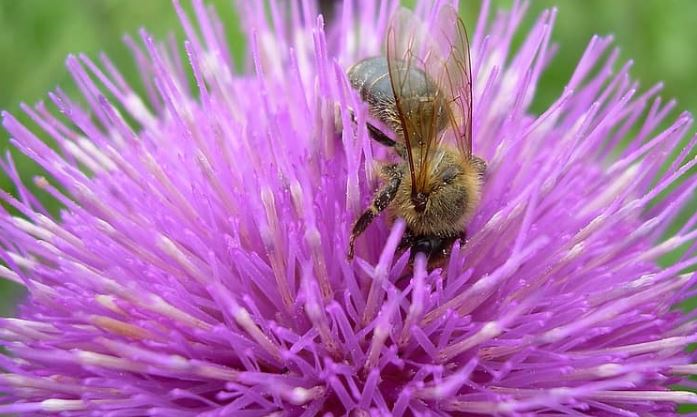Introduction
To make a prairie it takes a clover and one bee,
One clover, and a bee,
And revery.
The revery
alone will do
If bees are few.
-Emily Dickinson1

Figure 1 One clover and one bee make for revery.
Why should we preserve biodiversity? It seems like such a loaded question with the current events of a global and likely zoonotic pandemic afflicting the world at this moment. Intuitively, I believe that it is our responsibility to be better caretakers of the planet, to ensure Earth’s biodiversity is preserved for future generations; however, is there an argument that we should exploit Earth at all costs to feed and provide energy for the growing human population? Students will discuss the importance of maintaining ecosystems and will learn about the various arguments that people make in favor of preserving the Earth’s biodiversity.
A great entry event would be a field trip to the Phipps Botanical Gardens and/or Pittsburgh Zoo. The project workflow will have students view photos of endangered species on the Internet and discuss the reasons why these animals are threatened and why they should be protected and ask students to explain why all the members of an ecosystem are important. As a Geometry class, we will determine why the hexagon is the strongest shape and why it is nature’s most efficient shape. Locally, we will investigate human activities (use of pesticides, landscaping for agriculture (mono-cropping)2 and condos, climate change, relocating nonnative bee species) and colony collapsing disorder (Varroa mites and deformed wing virus) concerning Pennsylvania bees (Agapostemon sweat bee, American bumble bee, Augochlora sweat bee, bicolored Agapostemon sweat bee, common eastern bumble bee, eastern carpenter bee, golden northern bumble bee, leaf-cutter bee, long-horned bee, mason bee, small carpenter bee, sweat bee, tri-colored bumble bee, two-spotted longhorn bee). Once students have a foundational understanding and appreciation of bees, we will examine reasons for their decline. Students will learn about the research into the main disease, Varroa mites and deformed wing virus, that is killing bees and what is being done to help them. Students will evaluate data and consider the impacts that an environment without bees might look like, including the human costs such as the impact on food production and the increased use of pesticides.
The University of Pittsburgh was officially certified last spring as Bee Campus USA through the nonprofit Xerces Society for Invertebrate Conservation. I am looking forward to having the students examine the many ways that bees and humans impact biodiversity, and whether they have an obligation as caretakers who preserve other species even for purely aesthetic reasons versus exploiters that ruthlessly modify Earth on their ‘evolutionary path’ as a species. I await the opportunity of discovery through research where the students consider how climate change/global warming effects or alters the ecosystem, the bio geography and behavior of species – including humans.
Rationale
I believe that the classroom is one of the few environments where social justice and equity can exist. As an inner city, public school educator I am morally obligated to advocate for the students who are underserved. At Brashear, where the student population is approximately 42% Black, 36% White, 11% Asian, 5% Hispanic, & 6% two or more races, it is important that students have a voice and a choice on how they are receiving their education. In 2014, I was part of the two-year DEbT-M (Designing for Equity by Thinking in and about Mathematics) cohort where educators address racially based inequities in secondary mathematics education in the United States. We spent two years building an understanding of the opportunity gaps and the inequitable teaching practices. We became empowered as change agents to disrupt these inequitable practices and improve mathematics teaching and learning in ways that provide students of color with more equitable opportunities in mathematics.
As a mathematics teacher at Brashear high school’s STEAM academy, we have the distinct opportunity of using 90 minutes during our block scheduling to implement project-based learning. Ever since our insightful principal, Ms. Kimberly Safran, presented the documentary “Most Likely to Succeed” back in 2015 to the entire staff, we have been exploring compelling new approaches that aim to reimagining education as we know it. Brashear has developed a STEAM Academy within its curriculum offerings that consists of ten dedicated educators and approximately 250 (out of approximately 1,300) inspiring students that desire to revolutionize what education is capable of achieving through inquiry-based learning or learning by doing.

Comments: